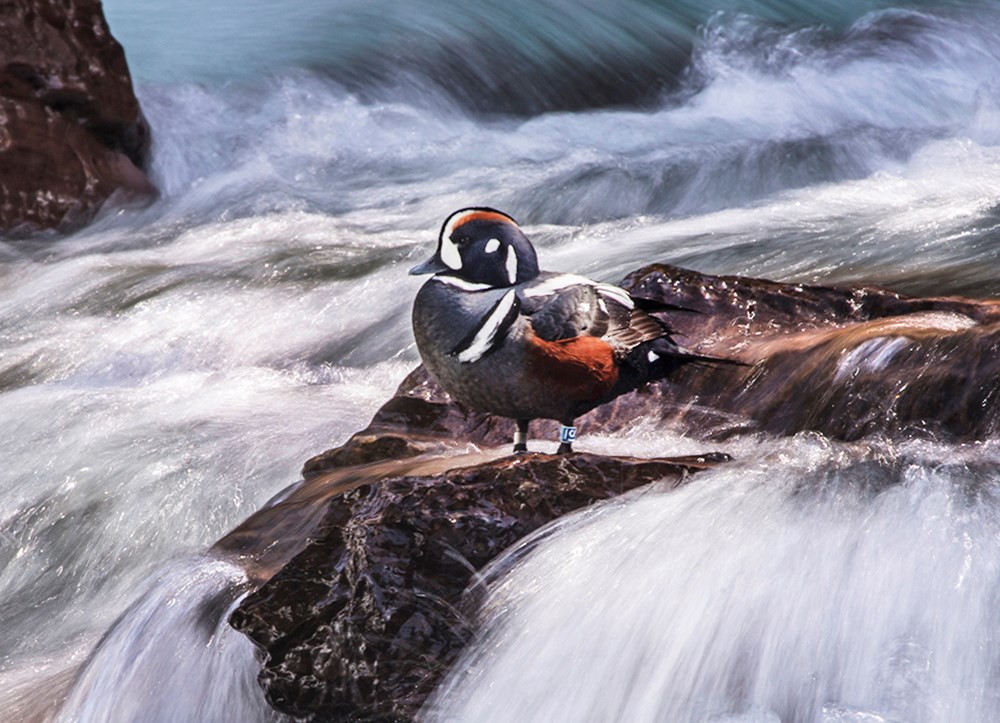Last updated: June 17, 2022
Article
Harlequin Ducks Resource Brief
Background Information

Harlequin ducks are the only North American duck species specialized to fast-moving water habitats. Glacier National Park’s cold, clear streams are critical breeding habitat for these charismatic birds.
Threats
Harlequins face many threats, including climate change, habitat loss, human disturbance, and oil spills. Nests are usually located within three feet of rushing streams, so any sudden flood can destroy them. As climate change progresses, weather and snowmelt cycles are expected to become more volatile, increasing the chances of flooding events. Habitat loss and human disturbance are also a growing problem, exacerbated by the fact that female harlequins will only return to their natal streams to breed and raise chicks. If the females on a particular tributary are lost, it is highly unlikely that this stream will ever be re-populated. Harlequins are subject to threats outside their breeding habitat as well—once they leave Glacier, they use multiple locations for molting and wintering. Many of Montana’s harlequins winter in the Strait of Georgia, inland of Vancouver Island, which is seeing increased oil shipments. Past oil spills in nearby wintering grounds have been disastrous, killing thousands of these coastal birds.
With their whimsical, colorful appearance, harlequin ducks are a favorite of birders and park visitors. In the West, harlequins are found from Wyoming to Alaska, breeding in mountain streams and wintering on the coast. Each year, female ducks return to the clear, fast-moving streams of their birth to breed and raise their chicks. By early fall, they migrate to the tumultuous waters of the Pacific Coast to molt and spend the winter. This east-west migratory pattern is unusual among ducks, who generally migrate north-south. Harlequins are relatively rare in Montana, and are listed as a species of concern due to fairly low reproductive rates, habitat loss, human disturbance, and climate change impacts. Glacier National Park’s Upper McDonald Creek has the highest density of breeding harlequin ducks in the contiguous United States; twenty-five percent of all chicks born in Montana are raised within this drainage.
Female harlequins return to their natal streams, the tributaries where they were born, each spring. While still on the coast, the female selects a mate—a bond that generally lasts for life. In May, the male harlequin follows the female inland to her natal stream, where he guards her while she forages. This allows her to accumulate the necessary fat resources to develop and lay eggs. Once the female lays her clutch of five to six eggs in a nest along the stream, the male departs for the coast to molt, leaving her to incubate the eggs alone. She relies on her skillful concealment of the nest to avoid predation, but without her mate, she cannot produce a second clutch should she lose her nest or brood. The female harlequin rears her chicks during the summer, and by early fall they migrate together to the coast, where they will ride out the stormy winter.
Status and Trends
Harlequin populations are declining throughout the West. The population on Glacier’s Upper McDonald Creek appears to be the only known exception to this trend. Based on annual surveys conducted since 1991, an average of nine pairs and ten chicks have been observed within this drainage each year. Although this particular population appears stable, overall low numbers have prompted biologists to carefully initiate research throughout the duck’s western range.
Recent studies and ongoing monitoring efforts by park biologists have focused on two main threats to Glacier’s harlequins: a warming climate and increasing human disturbance. A master’s thesis, completed in 2014 by Warren Hansen, assessed the impact of increased springtime stream volatility due to climate change. Results indicate that this volatility will lead to more frequent flooding of harlequin nests on riverbanks. In recent years, park biologists have discovered some ducks perching their nests in higher locations above the stream, away from a potential flooding hazard. In addition, Glacier’s current spike in visitation (a nearly 50% increase in summer numbers over the last two years) has prompted park scientists to better assess how human use impacts duck behavior. Harlequins are sensitive to human presence, particularly when raising their broods—females with chicks have been observed abandoning areas with high human use.

Management Strategy
In response to declining populations across the West, biologists from many states and provinces are collaborating on an extensive project to study these birds year-round. This work involves annual pair and brood counts, banding of chicks and adults, satellite telemetry, and geolocation tagging to provide data on the timing and specific locations of migration, molting, and wintering.
The park’s monitoring work provides up-to-date information on important data such as pair and chick numbers. Should these markers change, resource managers will develop and implement mitigation plans in response. For example, seasonal closures or restricted access to certain areas might be enforced if evidence shows that human disturbance is threatening stable harlequin populations. The more we learn about these charismatic birds, the better we can work to protect them and their unique habitat within Glacier National Park.
Resources for More Information
Glacier National Park Staff
- Lisa Bate, Wildlife Biological Science Technician
- John Waller, Supervisory Wildlife Biologist
Documents and web sites
- The Cornell Lab of Ornithology’s Birds of North America – https://birdsna.org/Species-Account/bna/species/harduc/introduction
- NatureServe Explorer: An Online Encyclopedia for Life – http://www.natureserve.org/explorer
- Warren Hansen Master’s Thesis – https://irma.nps.gov/DataStore/Reference/Profile/2215339
- “Lord and Ladies: The Harlequin Ducks of Glacier” video – https://www.nps.gov/rlc/crown/media.htm
The Crown of the Continent Research Learning Center
Phone: 406-888-7894; Email: melissa_sladek@nps.gov
Website: www.nps.gov/rlc/crown
